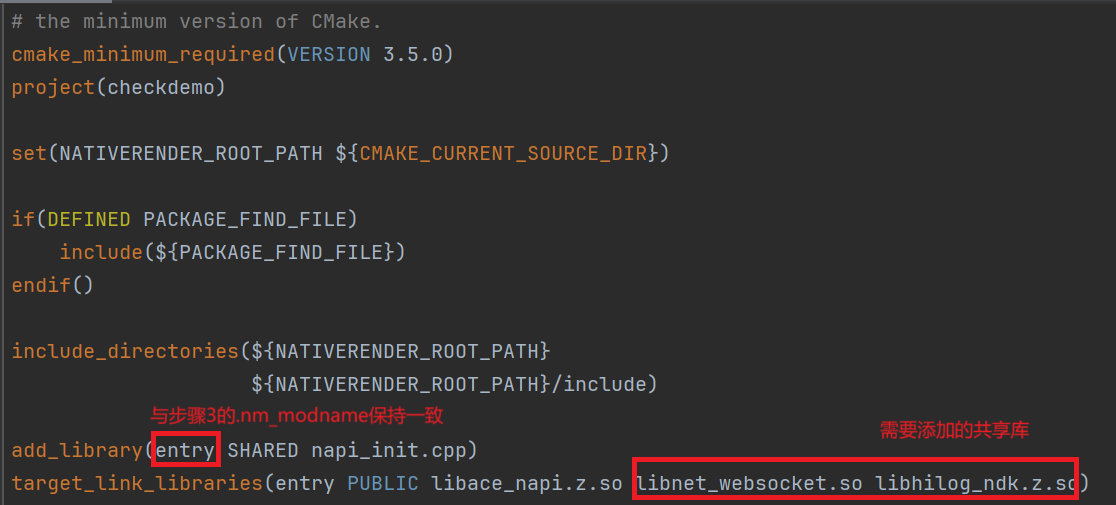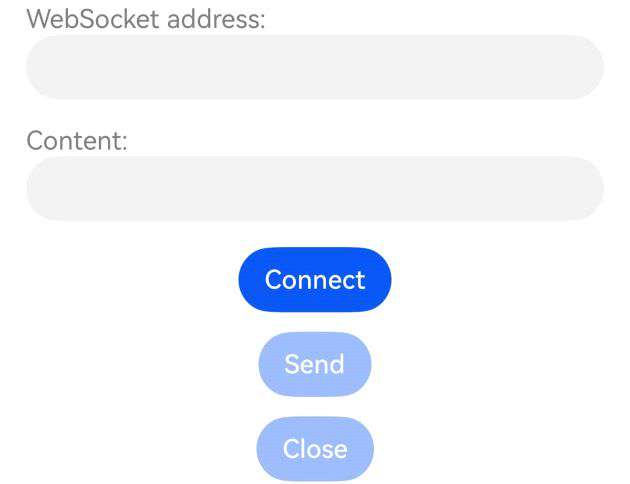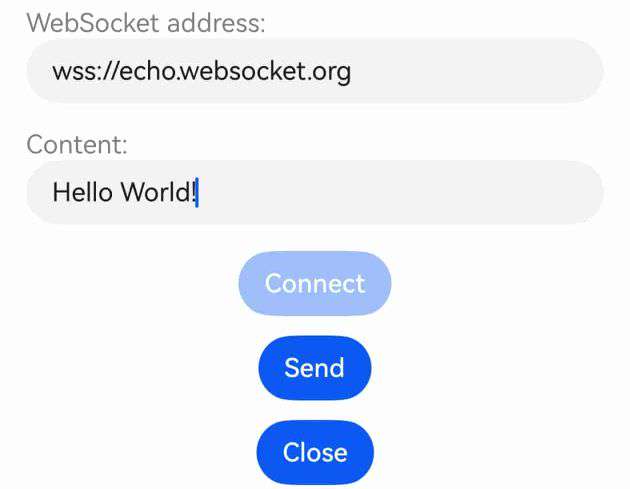harmony 鸿蒙WebSocket连接(C/C++)
WebSocket连接(C/C++)
场景介绍
通过WebSocket模块可以建立服务器与客户端的双向连接。
接口说明
WebSocket常用接口如下表所示,详细的接口说明请参考net_websocket.h。
| 接口名 | 描述 |
|---|---|
| OH_WebSocketClient_Constructor(WebSocket_OnOpenCallback onOpen, WebSocket_OnMessageCallback onMessage, WebSocket_OnErrorCallback onError, WebSocket_OnCloseCallback onclose) | Websocket客户端的构造函数。 |
| OH_WebSocketClient_AddHeader(struct WebSocket *client, struct WebSocket_Header header) | 将header头信息添加到client客户端request中。 |
| OH_WebSocketClient_Connect(struct WebSocket *client, const char *url, struct WebSocket_RequestOptions options) | 客户端连接服务端。 |
| OH_WebSocketClient_Send(struct WebSocket *client, char *data, size_t length) | 客户端向服务端发送数据。 |
| OH_WebSocketClient_Close(struct WebSocket *client, struct WebSocket_CloseOption options) | 客户端主动关闭websocket连接。 |
| OH_WebSocketClient_Destroy(struct WebSocket *client) | 释放websocket连接上下文和资源。 |
WebSocket接口开发示例
开发步骤
使用本文档涉及接口创建并连接到WebSocket服务器时,需先创建Native C++工程,在源文件中将相关接口封装,再在ArkTS层对封装的接口进行调用,使用hilog或者console.log等手段选择打印在控制台或者生成设备日志。
本文以实现建立与WebSocket服务器的连接、发送消息给WebSocket服务器、关闭WebSocket连接为例,给出具体的开发指导。
添加开发依赖
添加动态链接库
CMakeLists.txt中添加以下lib:
libace_napi.z.so
libnet_websocket.so
头文件
#include "napi/native_api.h"
#include "network/netstack/net_websocket.h"
#include "network/netstack/net_websocket_type.h"
构建工程
1、在源文件中编写调用该API的代码,接受ArkTS传递过来的url字符串参数,创建WebSocket对象指针后,检查连接到服务器是否成功。
#include "napi/native_api.h"
#include "network/netstack/net_websocket.h"
#include "network/netstack/net_websocket_type.h"
#include "hilog/log.h"
#include <cstring>
#undef LOG_DOMAIN
#undef LOG_TAG
#define LOG_DOMAIN 0x3200 // 全局domain宏,标识业务领域
#define LOG_TAG "WSDEMO" // 全局tag宏,标识模块日志tag
// WebSocket客户端全局变量
static struct WebSocket *client = nullptr;
static void onOpen(struct WebSocket *client, WebSocket_OpenResult openResult)
{
(void)client;
OH_LOG_INFO(LOG_APP, "onOpen: code: %{public}u, reason: %{public}s",
openResult.code, openResult.reason);
}
static void onMessage(struct WebSocket *client, char *data, uint32_t length)
{
(void)client;
char *tmp = new char[length + 1];
for (uint32_t i = 0; i < length; i++) {
tmp[i] = data[i];
}
tmp[length] = '\0';
OH_LOG_INFO(LOG_APP, "onMessage: len: %{public}u, data: %{public}s",
length, tmp);
}
static void onError(struct WebSocket *client, WebSocket_ErrorResult errorResult)
{
(void)client;
OH_LOG_INFO(LOG_APP, "onError: code: %{public}u, message: %{public}s",
errorResult.errorCode, errorResult.errorMessage);
}
static void onClose(struct WebSocket *client, WebSocket_CloseResult closeResult)
{
(void)client;
OH_LOG_INFO(LOG_APP, "onClose: code: %{public}u, reason: %{public}s",
closeResult.code, closeResult.reason);
}
static napi_value ConnectWebsocket(napi_env env, napi_callback_info info)
{
size_t argc = 2;
napi_value args[2] = {nullptr};
napi_value result;
napi_get_cb_info(env, info, &argc, args , nullptr, nullptr);
size_t length = 0;
napi_status status = napi_get_value_string_utf8(env, args[0], nullptr, 0, &length);
if (status != napi_ok) {
napi_get_boolean(env, false, &result);
return result;
}
if (client != nullptr) {
OH_LOG_INFO(LOG_APP, "there is already one websocket client running.");
napi_get_boolean(env, false, &result);
return result;
}
char *buf = new char[length + 1];
std::memset(buf, 0, length + 1);
napi_get_value_string_utf8(env, args[0], buf, length + 1, &length);
// 创建WebSocket Client对象指针
client = OH_WebSocketClient_Constructor(onOpen, onMessage, onError, onClose);
if (client == nullptr) {
delete[] buf;
napi_get_boolean(env, false, &result);
return result;
}
// 连接buf存放的URL对应的WebSocket服务器
int connectRet = OH_WebSocketClient_Connect(client, buf, {});
delete[] buf;
napi_get_boolean(env, connectRet == 0, &result);
return result;
}
static napi_value SendMessage(napi_env env, napi_callback_info info)
{
size_t argc = 1;
napi_value args[1] = {nullptr};
napi_value result;
napi_get_cb_info(env, info, &argc, args , nullptr, nullptr);
size_t length = 0;
napi_status status = napi_get_value_string_utf8(env, args[0], nullptr, 0, &length);
if (status != napi_ok) {
napi_create_int32(env, -1, &result);
return result;
}
if (client == nullptr) {
OH_LOG_INFO(LOG_APP, "websocket client not connected.");
napi_create_int32(env, WebSocket_ErrCode::WEBSOCKET_CLIENT_NULL, &result);
return result;
}
char *buf = new char[length + 1];
std::memset(buf, 0, length + 1);
napi_get_value_string_utf8(env, args[0], buf, length + 1, &length);
// 发送buf中的消息给服务器
int ret = OH_WebSocketClient_Send(client, buf, length);
delete[] buf;
napi_create_int32(env, ret, &result);
return result;
}
static napi_value CloseWebsocket(napi_env env, napi_callback_info info)
{
napi_value result;
if (client == nullptr) {
OH_LOG_INFO(LOG_APP, "websocket client not connected.");
napi_create_int32(env, -1, &result);
return result;
}
// 关闭WebSocket连接
int ret = OH_WebSocketClient_Close(client, {
.code = 0,
.reason = "Actively Close",
});
// 释放WebSocket资源并置空
OH_WebSocketClient_Destroy(client);
client = nullptr;
napi_create_int32(env, ret, &result);
return result;
}
简要说明:ConnectWebsocket函数接收一个WebSocket URL,并尝试连接,如果能连接成功,则返回true,否则返回false。在创建WebSocket结构体指针代表WebSocket客户端前,需要定义好该客户端在接收连接开启消息时的回调onOpen、接收到普通消息的回调onMessage、接收到错误消息时的回调onError、接收到关闭消息时的回调onClose。在示例代码中,还调用了OH_WebSocketClient_Send、OH_WebSocketClient_Close等函数向服务器发送消息,主动关闭WebSocket连接。
2、将通过napi封装好的napi_value类型对象初始化导出,通过外部函数接口,将函数暴露给JavaScript使用。示例代码中,ConnectWebsocket函数就会作为外部函数Connect暴露出去;SendMessage函数作为外部函数Send暴露出去;CloseWebsocket函数作为外部函数Close暴露出去。
EXTERN_C_START
static napi_value Init(napi_env env, napi_value exports) {
napi_property_descriptor desc[] = {
{"Connect", nullptr, ConnectWebsocket, nullptr, nullptr, nullptr, napi_default, nullptr },
{"Send", nullptr, SendMessage, nullptr, nullptr, nullptr, napi_default, nullptr },
{"Close", nullptr, CloseWebsocket, nullptr, nullptr, nullptr, napi_default, nullptr},
};
napi_define_properties(env, exports, sizeof(desc) / sizeof(desc[0]), desc);
return exports;
}
EXTERN_C_END
3、将上一步中初始化成功的对象通过RegisterEntryModule函数,使用napi_module_register函数将模块注册到 Node.js 中。
static napi_module demoModule = {
.nm_version = 1,
.nm_flags = 0,
.nm_filename = nullptr,
.nm_register_func = Init,
.nm_modname = "entry",
.nm_priv = ((void*)0),
.reserved = { 0 },
};
extern "C" __attribute__((constructor)) void RegisterEntryModule(void)
{
napi_module_register(&demoModule);
}
4、在工程的index.d.ts文件中定义函数的类型。比如,Connect函数接受一个string参数作为入参,并返回boolean值指示WebSocket连接是否能成功建立。
export const Connect: (url: string) => boolean;
export const Send: (data: string) => number;
export const Close: () => number;
5、在index.ets文件中对上述封装好的接口进行调用。
import testWebsocket from 'libentry.so'
@Entry
@Component
struct Index {
@State wsUrl: string = ''
@State content: string = ''
@State connecting: boolean = false
build() {
Navigation() {
Column() {
Column() {
Text("WebSocket address: ")
.fontColor(Color.Gray)
.textAlign(TextAlign.Start)
.width('100%')
TextInput()
.width('100%')
.onChange((value) => {
this.wsUrl = value
})
}
.margin({
bottom: 16
})
.padding({
left: 16,
right: 16
})
Column() {
Text("Content: ")
.fontColor(Color.Gray)
.textAlign(TextAlign.Start)
.width('100%')
TextInput()
.width('100%')
.enabled(this.connecting)
.onChange((value) => {
this.content = value
})
}
.margin({
bottom: 16
})
.padding({
left: 16,
right: 16
})
Blank()
Column({ space: 12 }) {
Button('Connect')
.enabled(!this.connecting)
.onClick(() => {
let connRet = testWebsocket.Connect(this.wsUrl)
if (connRet) {
this.connecting = true;
}
})
Button('Send')
.enabled(this.connecting)
.onClick(() => {
testWebsocket.Send(this.content)
})
Button('Close')
.enabled(this.connecting)
.onClick(() => {
let closeResult = testWebsocket.Close()
if (closeResult != -1) {
this.connecting = false
}
})
}
}
}
}
}
6、配置CMakeLists.txt,本模块需要用到的共享库是libnet_websocket.so,在工程自动生成的CMakeLists.txt中的target_link_libraries中添加此共享库。
注意:如图所示,在add_library中的entry是工程自动生成的modename,若要做修改,需和步骤3中.nm_modname保持一致。

7、调用WebSocket C API接口要求应用拥有ohos.permission.INTERNET权限,在module.json5中的requestPermissions项添加该权限。
经过以上步骤,整个工程的搭建已经完成,接下来就可以连接设备运行工程进行日志查看了。
测试步骤
1、连接设备,使用DevEco Studio打开搭建好的工程。
2、运行工程,设备上会弹出以下图片所示界面:

简要说明:
在第一行的输入框中,输入
ws://或wss://开头的WebSocket URL。在输入完WebSocket URL,点击
Connect按钮后,如果访问成功,会触发onOpen的回调,打印日志。在Content输入框里输入要发送给服务器的内容,点击
Send按钮发送。如果服务器返回消息,会触发onMessage回调,打印日志。点击
Close按钮,WebSocket连接释放,可以重新输入新的WebSocket URL。


你可能感兴趣的鸿蒙文章
- 所属分类: 后端技术
- 本文标签:
热门推荐
-
2、 - 优质文章
-
3、 gate.io
-
7、 openharmony
-
9、 golang